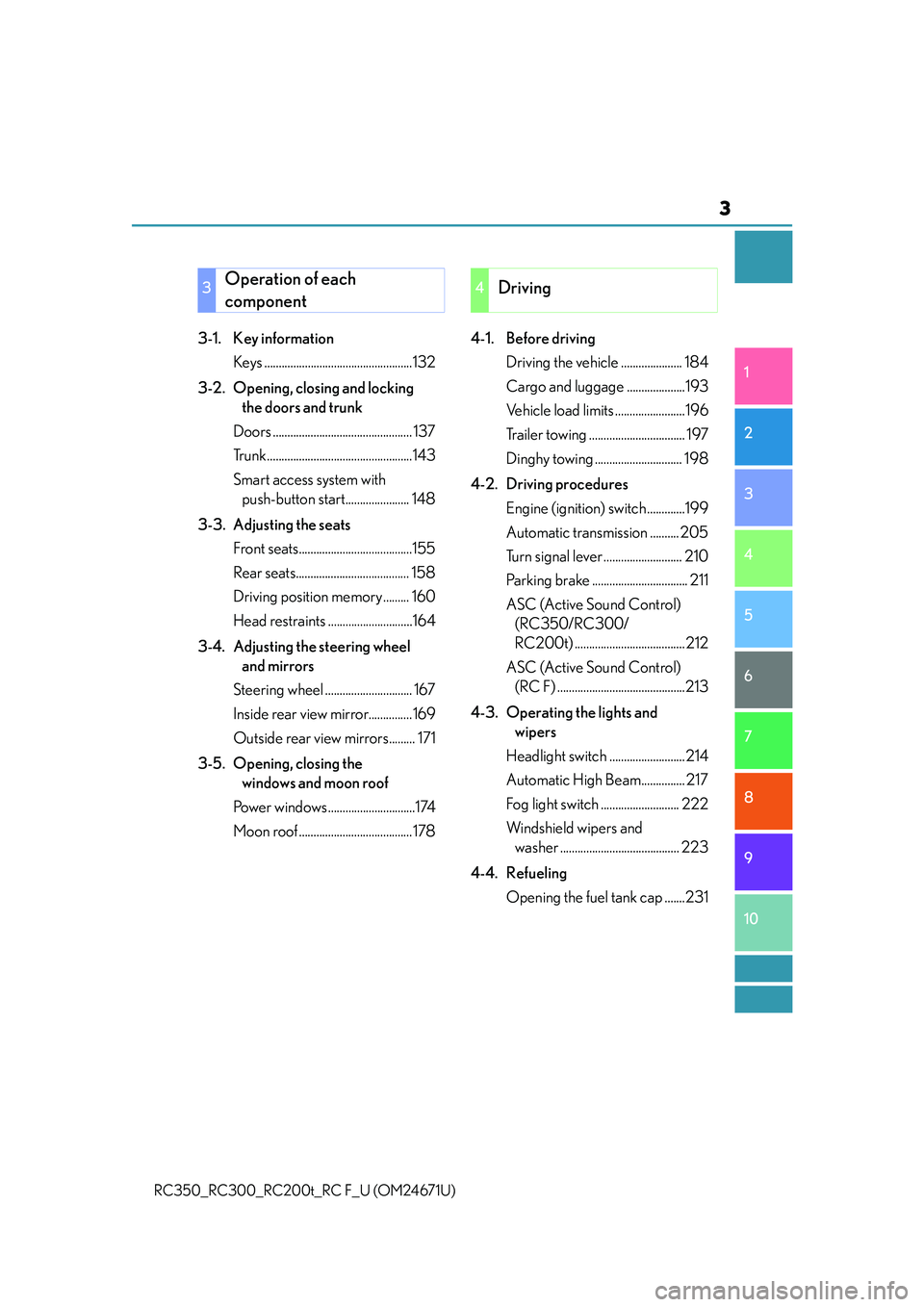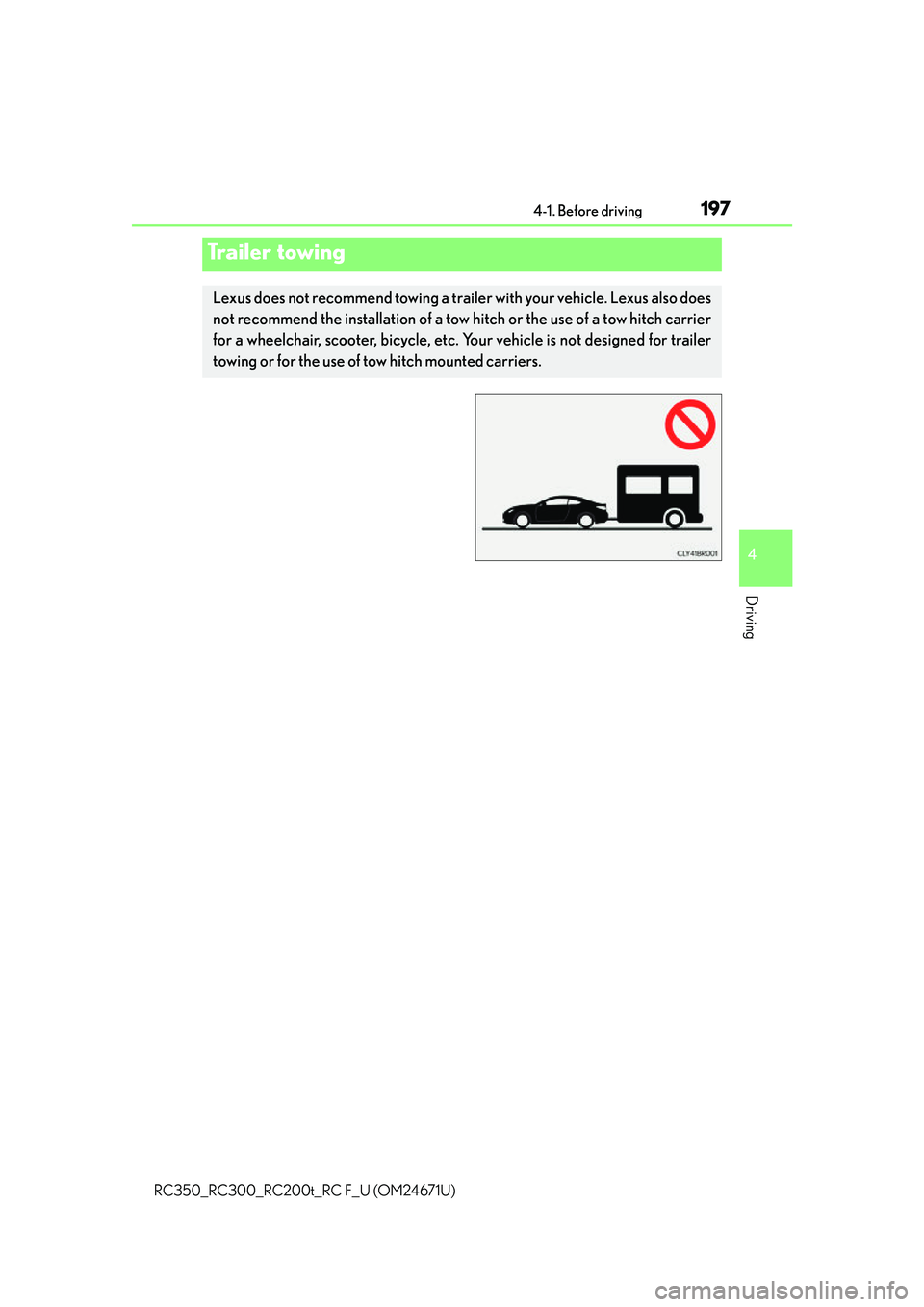trailer LEXUS RC F 2016 Owners Manual
[x] Cancel search | Manufacturer: LEXUS, Model Year: 2016, Model line: RC F, Model: LEXUS RC F 2016Pages: 700, PDF Size: 14.12 MB
Page 3 of 700

3
1
9 8
7 5 4
3
2
10
RC350_RC300_RC200t_RC F_U (OM24671U)
6
3-1. Key information Keys ...................................................132
3-2. Opening, closing and locking the doors and trunk
Doors ................................................ 137
Trunk..................................................143
Smart access system with push-button start...................... 148
3-3. Adjusting the seats Front seats.......................................155
Rear seats....................................... 158
Driving position memory......... 160
Head restraints .............................164
3-4. Adjusting the steering wheel and mirrors
Steering wheel .............................. 167
Inside rear view mirror...............169
Outside rear view mirrors......... 171
3-5. Opening, closing the windows and moon roof
Power windows ..............................174
Moon roof ....................................... 178 4-1. Before driving
Driving the vehicle ..................... 184
Cargo and luggage ....................193
Vehicle load limits ........................196
Trailer towing ................................. 197
Dinghy towing .............................. 198
4-2. Driving procedures Engine (ignition) switch.............199
Automatic transmission .......... 205
Turn signal lever ........................... 210
Parking brake ................................. 211
ASC (Active Sound Control) (RC350/RC300/
RC200t) ...................................... 212
ASC (Active Sound Control) (RC F) ............................................213
4-3. Operating the lights and wipers
Headlight switch .......................... 214
Automatic High Beam............... 217
Fog light switch ........................... 222
Windshield wipers and washer ......................................... 223
4-4. Refueling Opening the fuel tank cap .......231
3Operation of each
component4Driving
Page 183 of 700

183
Driving4
RC350_RC300_RC200t_RC F_U (OM24671U)
4-1. Before drivingDriving the vehicle ...................... 184
Cargo and luggage .................... 193
Vehicle load limits ....................... 196
Trailer towing ..................................197
Dinghy towing...............................198
4-2. Driving procedures Engine (ignition) switch ............ 199
Automatic transmission .......... 205
Turn signal lever ........................... 210
Parking brake ..................................211
ASC (Active Sound Control)
(RC350/RC300/
RC200t)...................................... 212
ASC (Active Sound Control) (RC F)............................................ 213
4-3. Operating the lights and wipers
Headlight switch .......................... 214
Automatic High Beam .............. 217
Fog light switch............................ 222
Windshield wipers and washer..........................................223
4-4. Refueling Opening the fuel tank cap....... 231 4-5. Using the driving support
systems
Cruise control ............................. 235
Dynamic radar cruise control ......................................... 239
LDA (Lane Departure Alert) ........ 253
Intuitive parking assist .............. 259
Lexus parking assist monitor ........................................ 268
Driving mode select switch ........................................... 283
Driving assist systems............... 287
PCS (Pre-Collision System).......... 295
BSM (Blind Spot Moni tor)..............302
• BSM function .........................306
• RCTA function ....................... 310
Active rear wing .......................... 315
TVD (Torque Vectoring Differential)................................. 318
4-6. Driving tips Winter driving tips .....................320
Page 193 of 700

1934-1. Before driving
4
Driving
RC350_RC300_RC200t_RC F_U (OM24671U)
Cargo capacity depends on the total weight of the occupants.
(Cargo capacity) = (Total load capacity) — (Total weight of occupants)
Steps for Determining Correct Load Limit —
(1) Locate the statement “The combined weight of occupants and cargo should never exceed XXX kg or XXX lbs.” on your vehicle’s placard.
(2) Determine the combined weight of the driver and passengers that will be
riding in your vehicle.
(3) Subtract the combined weight of the driver and passengers from XXX kg or
XXX lbs.
(4) The resulting figure equals the ava ilable amount of cargo and luggage load
capacity.
For example, if the “XXX” amount equals 1400 lbs. and there will be five 150
lb passengers in your vehicle, the am ount of available cargo and luggage load
capacity is 650 lbs. (1400 750 (5 150) = 650 lbs.)
(5) Determine the combined weight of luggage and cargo being loaded on the
vehicle. That weight may not safely exceed the available cargo and luggage
load capacity calculated in Step 4.
(6) If your vehicle will be towing a trailer, load from your trailer will be transferred
to your vehicle. Consult this manual to determine how this reduces the avail-
able cargo and luggage load capacity of your vehicle.
( P. 1 9 6 )
Lexus does not recommend towing a trailer with your vehicle. Your vehicle is not
designed for trailer towing.
Cargo and luggage
Take notice of the following information about storage precautions, cargo
capacity and load:
Capacity and distribution
Page 196 of 700

1964-1. Before driving
RC350_RC300_RC200t_RC F_U (OM24671U)
◆Total load capacity (vehicle capacity weight): ( P. 6 1 8 )
Total load capacity means the combined weight of occupants, cargo and lug-
gage.
◆Seating capacity: 4 occupants (Front 2, Rear 2)
Seating capacity means the maximum number of occupants whose estimated
average weight is 150 lb. (68 kg) per person.
◆To w i n g c a p a c i t y
Lexus does not recommend towing a trailer with your vehicle.
◆Cargo capacity
Cargo capacity may increase or decrea se depending on the weight and the
number of occupants.
■Total load capacity and seating capacity
These details are also described on the tire and loading information label. (P. 5 1 0 )
Vehicle load limits
Vehicle load limits include total load capacity, seating capacity, towing capac-
ity and cargo capacity.
WA R N I N G
■Overloading the vehicle
Do not overload the vehicle.
It may not only cause damage to the tires, but also degrade steering and braking ability,
resulting in an accident.
Page 197 of 700

1974-1. Before driving
4
Driving
RC350_RC300_RC200t_RC F_U (OM24671U)
Trailer towing
Lexus does not recommend towing a trailer with your vehicle. Lexus also does
not recommend the installation of a tow hitch or the use of a tow hitch carrier
for a wheelchair, scooter, bicycle, etc. Your vehicle is not designed for trailer
towing or for the use of tow hitch mounted carriers.
Page 219 of 700

2194-3. Operating the lights and wipers
4
Driving
RC350_RC300_RC200t_RC F_U (OM24671U)
■The Automatic High Beam can be operated when
The engine switch is in IGNITION ON mode.
■Camera sensor detection information
●High beam may not be automatically tu rned off in the following situations:
• When oncoming vehicles sudd enly appear from a curve
• When the vehicle is cut in front of by another vehicle
• When oncoming or preceding vehicles are hidden from sight due to repeated
curves, road dividers or roadside trees
●High beam may be turned off if an oncoming vehicle that is using fog lights without
using the headlights is detected.
●House lights, street lights, red traffic signals, and illuminated billboards or signs may
cause the high beam to turn off.
●The following factors may affect the amount of time taken to turn high beam on or off:
• The brightness of headlights, fog lights, and tail lights of oncoming and preceding
vehicles
• The movement and direction of oncoming and preceding vehicles
• When an oncoming or preceding vehicle only has operational lights on one side
• When an oncoming or preceding vehicle is a two-wheeled vehicle
• The condition of the road (gradient, curve, condition of the road surface etc.)
• The number of passengers and amount of luggage
●High beam may be turned on or off when unexpected by the driver.
●Small vehicles, such as bicy cles, may not be detected.
●In the situations below, the system may not be able to correctly detect the surrounding
brightness levels, and may flash or expose nearby pedestrians to the high beam. There-
fore, you should consider turning the high be ams on or off manually rather than relying
on the Automatic High Beam system.
• In bad weather (rain, snow, fog, sandstorms etc.)
• The windshield is obscured by fog, mist, ice, dirt etc.
• The windshield is cracked or damaged.
• The camera sensor is deformed or dirty.
• Surrounding brightness levels are equal to those of headlights, tail lights or fog lights.
• Vehicles ahead have headlights or tail lights that are either switched off, dirty, chang-
ing color, or have improperly adjusted aim.
• When driving through an area of intermit tently changing brightness and darkness.
• When frequently and repeatedly driving ascending/descending roads, or roads with
rough, bumpy or uneven surfaces (such as stone-paved roads, gravel tracks etc.).
• When frequently and repeat edly taking curves or driving on a winding road.
• There is a highly reflective object ahead of the vehicle, such as a sign or a mirror.
• The vehicle’s headlights are damaged or dirty.
• The vehicle is listing or titling, due to a flat tire, a trailer being towed etc.
• The driver believes that the high beam may be causing problems or distress to other
drivers or pedestrians nearby.
Page 697 of 700

697Alphabetical index
RC350_RC300_RC200t_RC F_U (OM24671U)
Tools................................................. 571, 585
Top tether strap........................................ 73
Torque Vectoring Differential (TVD) ...................................................... 318
Total load capacity .................................196
Towing Dinghy towing ...................................... 198
Emergency towing ............................534
Towing eyelet.......................................537
Trailer towing .........................................197
TRAC (Traction Control) ................. 287
Traction Control (TRAC) ................. 287
Trailer towing ........................................... 197
Transmission ........................................... 205 Automatic transmission ................. 205
Driving mode select switch ......... 283
If the shift lever cannot be shifted from P .................................. 599
M mode ................................................. 208
Paddle shift switches ........... 207, 208
Trip meters .........................................92, 98 Trunk ........................................................... 143
Internal trunk release lever .............145
Luggage security system................. 144
Smart access system with push-button start.................... 143
Trunk features......................................438
Trunk grip ................................................ 144
Trunk light................................................145
Trunk opener main switch .............. 144
Trunk opener switch .......................... 143
Trunk storage extension ................ 442
Wireless remote control.................. 143
Trunk light.................................................. 145 Wattage .................................................635
Turn signal lights ..................................... 210 Replacing light bulbs .............................524, 526, 529
Turn signal lever ...................................210
Wattage .................................................635
TVD (Torque Vectoring Differential) ...........................................318
*: For vehicles with a navigation system, refer to the
“NAVIGATION SYSTEM OWNER’S MANUAL”.